David's Astronomy Pages
CCD Images - Session 743 (2020-01-19)
Images
(S742)
Images
Sessions
Home
Page
Images
(S744)
David's Astronomy Pages
|
Images (S742) |
Images Sessions |
Home Page |
Images (S744) |
Objects Session Notes
Minkowski 1-8 - Planetary Nebula (PN G210.3+1.9) 3C 58 - Supernova Remnant (attempt) Variable Stars (photometric monitoring) - RX And, Z And, AM CVn, SY Cnc, R CrB, S Cyg, SS Cyg, U Gem, AM Her, SS Her, U Her, RZ LMi, BL Lac, CY Lyr, FU Ori, DY Per, GK Per, FG Sge, V Sge, RR Tau, ER UMa
- FO Ori attempt failed (aborted)Nearby Stars (astrometric monitoring) - None
- All night session (8 hours total).
Shutter closed at 04:34 after Job Queue hung.
- Main aims of the session was to acquire a selection of targets, including variable stars, nearby stars and a few specially selected deep sky objects. - 12" LX200 + ST-10XME for imaging - TS 80mm APO + ZWO ASI178MC for guiding & imaging - Ambient Temperature: -1°C (min) , rise to 4.5 deg in 15 min as warm front came through at 02:45
(Dew heaters on auto)- CCD Temperature: -25°/-20°C (80%/70% av. power) - Notes from 2020-01-19 >>
Minkowski 1-8 in Monoceros was the Deep Sky Challenge Object in Astronomy Now
Magazine for Feb 2020
It proved to be quite difficult to track down.
I couldn't find a positional reference in TheSky6 for PN G210.3+1.9, but the
finder chart in the magazine (but not the coordinates) implied it had a position
that corresponded to planetary nebula PLN 210+ 1.1.
Centering on PLN
210+1.1 coordinates RA 06 53 31.404, Dec +03 12 13.64 (Epoch 2000) no planetary
nebula could be seen at that location (absence confirmed by reviewing
spectroscopic images. However some 3.8' to the south there was
a small smudge of light (unnamed in TheSky6) at RA 06 53 33.79, Dec +03 08 26.59
(Epoch 2000) that has a spectrographic signature of a planetary nebula.
This is believed to be Minkowski 1-8.
| Minkowski 1-8 (Monoceros) Ast. Now Deep Sky Challenge Object, Feb 2020 Pl.Neb highlighted by white cross-hairs |
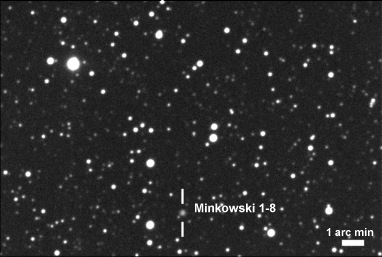 |
| Annotated CCD Image (50% size, linear scale) 4 x 30s exposure (average combine), 3x3 binning, C Filter 2020-01-19 23:26 UT (#743015-21) 12" LX200R (at f/10.4) + ST-10XME Auto-guided using TS 80mm APO, ZWO ASI178MC & PHD2 |
| Minkowski 1-8 - Detail (Pl.Neb at centre of cropped image) Est. Mag +15.1 |
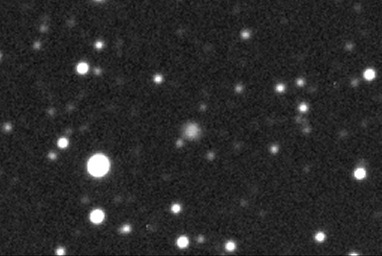 |
| CCD Image (150% size, linear scale, cropped) Image details as above |
| Minkowski 1-8 - Location (Pl.Neb location believed to be Minkowski 1-8) |
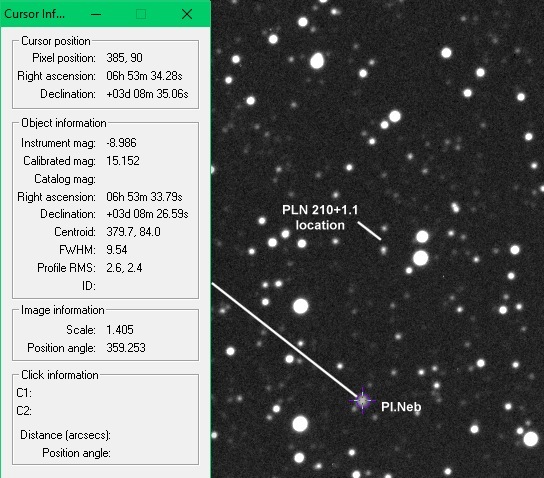 |
| CCD Image (150% size, linear scale, cropped) Image details as above |
| Minkowski 1-8 - Spectrographic Image (created using Star Analyser 2000 diffraction grating) |
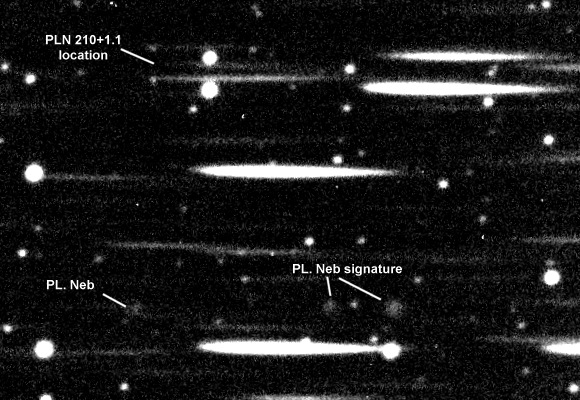 |
| CCD Image (100% size, linear scale, rotated, cropped) 5 x 60s exposure (average combine), 2x2 binning, S Filter 2020-01-19 23:32 UT (#743022-26) 12" LX200R (at f/10.4) + ST-10XME Auto-guided using TS 80mm APO, ZWO ASI178MC & PHD2 |
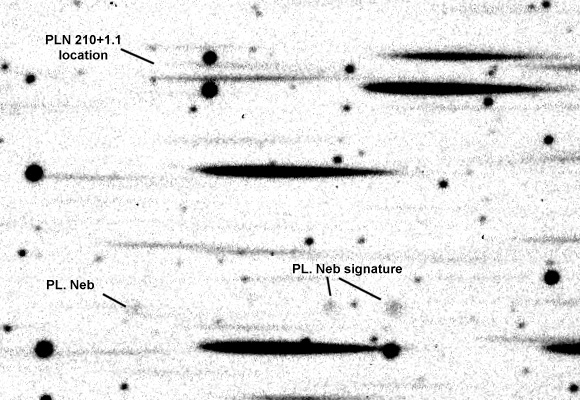 |
| Negative CCD Image (100% size, linear scale, rotated,
cropped) Image details as above |
Back to Top
| 3C 58 (Cassiopeia) Attempted image of supernova remnant 3C 58 (not visible) |
 |
| CCD Image (50% size) 8 x 180s exposure (average combine), 3x3 binning, C Filter 2020-01-20 02:03 UT (#743073-82) 12" LX200R (at f/10.4) + ST-10XME Auto-guided using TS 80mm APO, ZWO ASI178MC & PHD2 |
| 3C 58 Region Image affected by poor seeing but no sign of supernova remnant in this image (24 min total exposure ) |
 |
| CCD Image (85% size, cropped) Image details as above |
| 3C 58 Region - Detail Again no sign of supernova remnant in this image when image is pushed to maximum contrast |
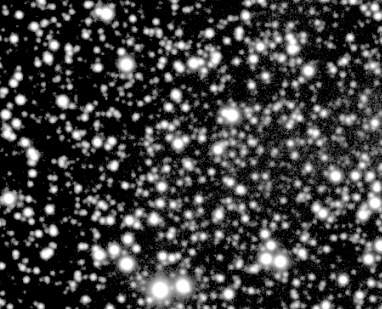 |
| CCD Image (85% size, cropped) Image details as above |
| 3C 58 - Reference Image (Credit: NASA/CXC/SAO) https://www.nasa.gov/chandra/multimedia/chandra-15th-anniversary-3c58.html |
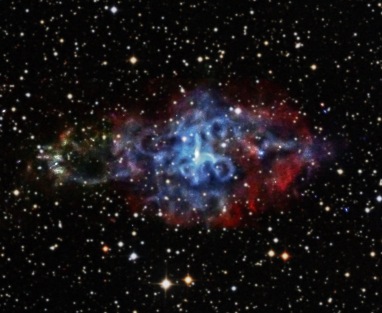 |
| Reference Image rescaled to same scale as above image |
| 3C 58 Region - Earlier Image (2020-01-18) Image affected by wind / surface & jet stream, uneven guiding |
 |
| CCD Image (85% size, cropped) 5 x 180s exposure (average combine), 3x3 binning, DB Filter 2020-01-18 23:14 UT (#742063-69) 12" LX200R (at f/10.4) + ST-10XME Attempted auto-guiding using TS 80mm APO, ZWO ASI178MC & PHD2 |
Back to Top
| This Web Page: | CCD Images - Session 743 (2020-01-19) |
| Last Updated : | 2020-07-19 |
| Site Owner : | David Richards |
| Home Page : | David's Astronomy Web Site |